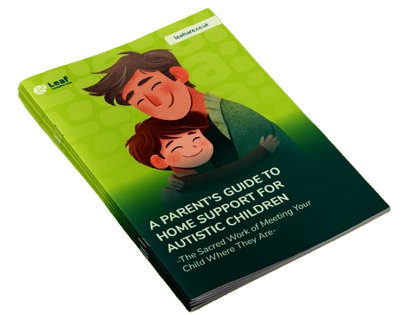Key Takeaways
- The Social Model of Disability, developed by disabled people, views disability as a societal issue rather than an individual one. It shows that people are disabled by societal barriers, such as physical and attitudinal, rather than their differences or impairments.
- It promotes the idea that society should adapt to include disabled people, challenging prejudices and misconceptions that have long marginalised them.
- The model distinguishes between ‘impairment’ and ‘disability’. It emphasises the need to remove these barriers, adopt an equality and rights-based approach, and involve disabled people in decision-making processes.
- The Medical Model views disability as a problem within the individual, best addressed through medical intervention. In contrast, the Social Model views disability as socially constructed, promoting equality, independence, choice, and control for disabled people.
- Leaf Complex Care provides human-first support, creates space for understanding disability and advocates for creating a more accessible and inclusive environment. We enable disabled people to achieve independent living and accessibility, inclusivity, and participation in all aspects of life.
Definition of The Social Model of Disability
Developed by disabled people, the Social Model of Disability is a way of viewing the world. People with an ‘impairment’ are disabled by society (the environment, policies and attitudes), not the other way around. Physical barriers, such as the absence of ramps or lifts in buildings and insufficient parking spaces for disabled people, further deepen these challenges. In general, the lack of equal opportunities and lack of inclusive access to community buildings poses many challenges and seeks an urgent social model solution.
Some of the attitudinal barriers, also known as social barriers imposed on disabled people in society include stereotyping, where individuals are unfairly characterised based on their disability; stigmatisation, which often leads to social exclusion and isolation; and discrimination, particularly in areas such as employment and education.
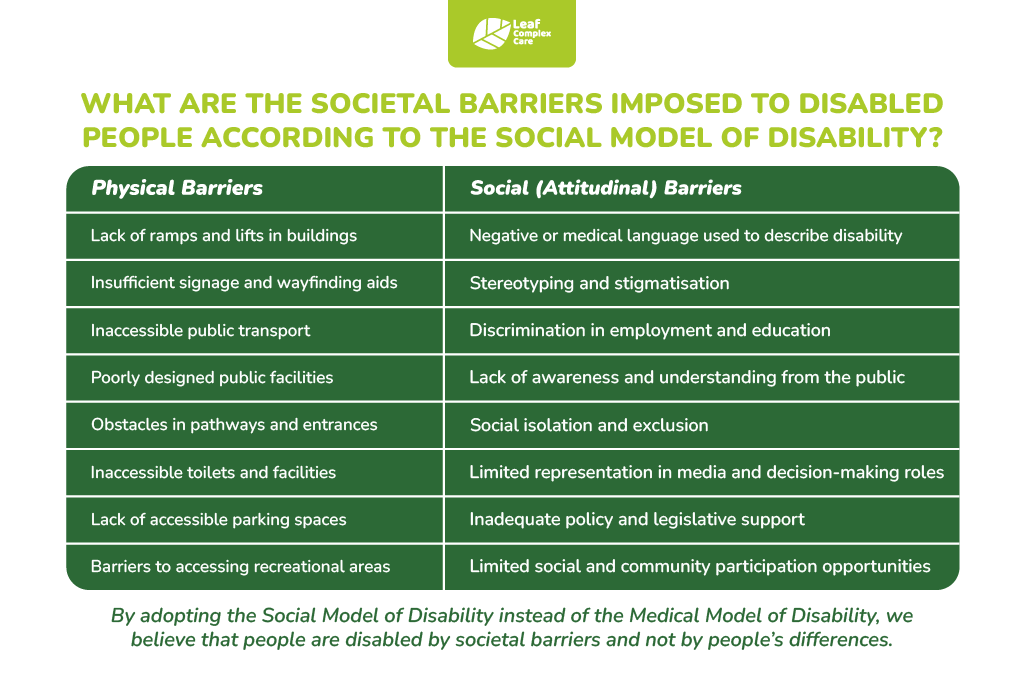
The purpose of the Social Model of Disability is to shift focusing solely on the person’s physical impairments caused by a ‘disease’ to include the individual’s physical and social environments. This approach recognises the need to alleviate limitations, supporting strength-based approaches ensuring comprehensive support for the person’s overall well-being and more independent living.
Changing Attitudes Towards Individuals With Disability
The way people act and interact is fundamental in changing perspectives. It is a natural human need for each person to feel recognised and valued for who they are. Offer respect, love, kindness, and genuine support in your words and actions. By shifting the focus from what people cannot do to how society can adapt to include them, we can challenge and dismantle the prejudices and misconceptions that have long marginalised disabled people.
Recognise the fundamental human need for understanding and connection while being sincere and honest in your efforts to create a safe and supportive environment where disabled people can thrive. This shift in attitude requires a concerted effort across all sectors of society, from media and education to employment and public services, ensuring that disabled people are respected and included in all aspects of life.
The Social Model of Disability encourages us to see disability as a natural part of human diversity, much like race or gender. Ultimately, the Social Model seeks to challenge power imbalances within society between differently-abled people and redefine disability as a diverse expression of human life. The Social Model recognises the need for societal changes to accommodate impairment as an expected part of human diversity and enable full participation of disabled people in society on an equal basis with others.
Core Principles of the Social Model of Disability
The Social Model of Disability emphasises that impairments only lead to disability when societal barriers prevent individuals from achieving their goals or participating fully in society.
The model clearly distinguishes between ‘impairment’ and ‘disability.’
Impairment refers to a person’s actual attributes or lack of attributes, such as the absence of a limb or a sensory function.
Disability is the restriction of activity implied by society that excludes people from participating in social activities.
The core principles of the Social Model of Disability include the following:
Disability as a Social Construct – The model asserts that disability is not an inherent attribute of the individual but is created by societal barriers and attitudes.
Focus on Removing Barriers – The Social Model emphasises the need to identify and dismantle barriers restricting disabled people’s access and opportunities.
Equality and Rights-Based Approach – It values the idea that disabled people have the same rights as everyone else to participate in all areas of life.
Inclusion in All Spheres of Life – The model encourages the empowerment of disabled people by involving them in decision-making processes and recognising their expertise in their own lives. It aims to create an inclusive society where disabled people have the support and accommodations necessary to thrive.
Societal Responsibility – The Social Model shifts the responsibility for addressing disability from the person to society. It calls for systemic changes, including policy reforms, public awareness campaigns, and inclusive design practices, to create environments that accommodate everyone.
Medical Model vs Social Model of Disability
Disability is a complex concept that has been understood and approached in various ways throughout history. Traditionally, disability was often seen through the lens of the Medical Model, which views it as a problem residing within the individual, caused by their physical condition, and best addressed through medical intervention. The barriers imposed on disabled people often use negative or medical language that affects their own lives.
However, a paradigm shift has occurred with the emergence of the Social Model of Disability, which offers a radically different perspective.
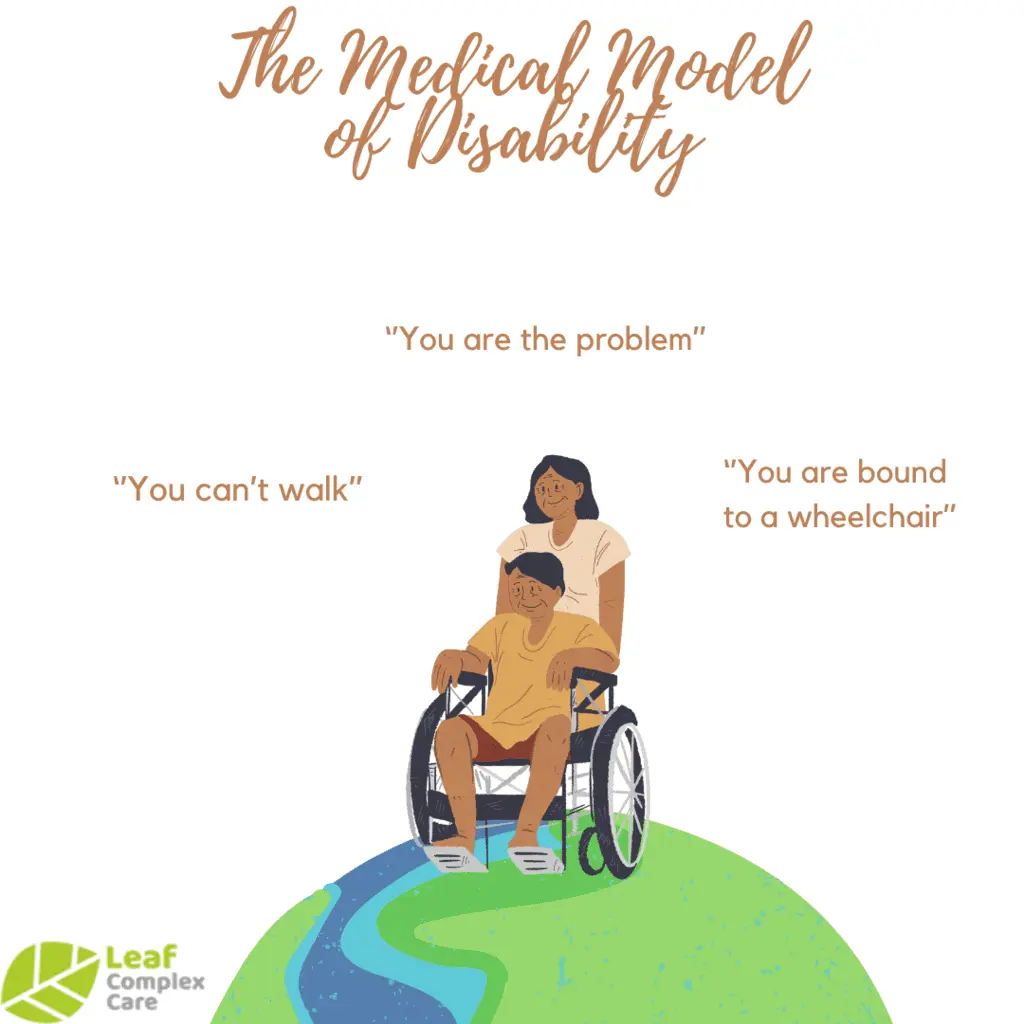
The Medical Model of Disability promotes the perspective that disability is a ‘deficiency’ or ‘abnormality’ within the person, focusing on the person’s impairments and limitations. It views disability as a medical issue that needs to be cured or treated, often through medical interventions, treatments, and assistive technologies. This model tends to see having a disability as a negative aspect, something that is in the person and is their problem to manage or cure, often with the help of health care and social service professionals. The Medical Model has been criticised for creating low expectations and leading to a loss of independence, choice, and control for people with disabilities.
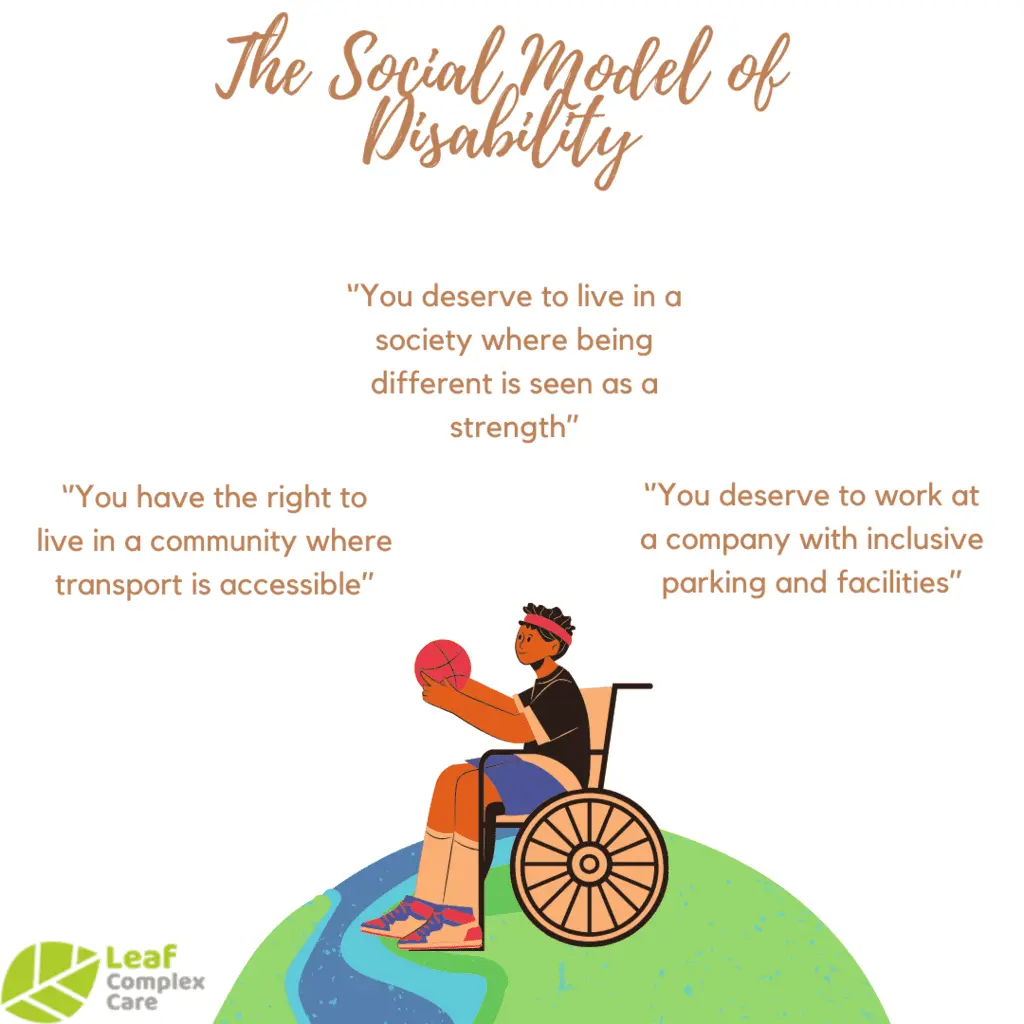
The Social Model of Disability promotes the understanding that disability is socially constructed, underlining the role of societal barriers, negative attitudes, and exclusionary practices in creating disability. It distinguishes between ‘impairment’ and ‘disability,’ locating the source of disability within the disabling society rather than within the person. It calls for an end to discrimination and oppression against people with disabilities through education and the use of the Social Model language, accommodation, and universal design, valuing a spectrum of abilities and promoting equality, independence, choice, and control. The Social Model also highlights the empowerment and self-advocacy of disabled people, encouraging them to become active voices in their own lives and society.
Examples of the Social Model in Real Life
In our everyday lives, we encounter diverse people with a wide range of abilities, and how we, as a society, choose to accommodate these differences can significantly impact their experiences. The Social Model of Disability provides a framework for understanding disability as a result of societal barriers rather than individual impairments. It also advocates for creating a more accessible and inclusive environment for all. Let’s explore a few scenarios to understand the Social Model of Disability in real-life situations and how it impacts the lives of people with different disabilities.
Example 1: Accessible Education
John lives with a learning difficulty and faces challenges participating in school classes due to the lack of support and understanding from teachers. By implementing inclusive teaching methods and additional learning support, such as extra time during exams and specialised tutoring, John can have equal access to education, boosting his self-esteem and respecting his human rights. This approach doesn’t focus on John’s disability but rather on the barriers that could hinder his learning process and can create social change by promoting diversity and understanding among non-disabled people.
Example 2: Employment Opportunities
Tom lives with a visual impairment and works in a tech company. The company has installed braille signs, provided screen reading software, and ensured that all company materials are available in accessible formats. This allows Tom to perform her job with the same efficiency as his colleagues and promotes a culture of inclusivity. The company’s approach enhances Tom’s independence and reinforces her human rights.
Example 3: Accessible Public Spaces
Sarah, a person who is physically impaired, lives in a city that has made public transportation, buildings, and public spaces accessible for all, including people with physical impairments. Ramps, tactile paving, and accessible toilets are commonplace. This allows Sarah to navigate the city more independently and helps create social change by normalising the presence and participation of disabled people in everyday life.
Creating disability equality involves reimagining physical structures and environments to ensure they are inclusive and do not imply disability as a limitation.
Impact on Disabled People
The Social Model perspective emphasises the need for a supportive societal framework to enable disabled people to achieve independent living as a positive outcome, countering the effects of discrimination and oppression. These essential frameworks, often referred to as the ‘pillars of independent living’, contain various components that create a significant impact on people’s lives, such as:
- Accessible and relevant information
- Sufficient income
- Accessible health and social care provision
- Adequate provision of personal assistance
- Fully accessible transport system
- Provision of technical aids and equipment
- Equal employment opportunities
- Environmental access
- Inclusive education and training opportunities
- Access to peer counselling
- Availability of accessible and adapted housing
- Access to independent advocacy and self-advocacy
Key Components of the Social Model
The fundamental key components of the Social Model of Disability is centred around equality. This struggle for equality is frequently likened to the challenges other socially marginalised groups face, as it represents a universal pursuit for fairness, justice, and recognition of human rights. Equal rights ensure people are treated fairly. They are also regarded as a means to empower disabled people, granting them the opportunity to make decisions and lead fulfilling lives.
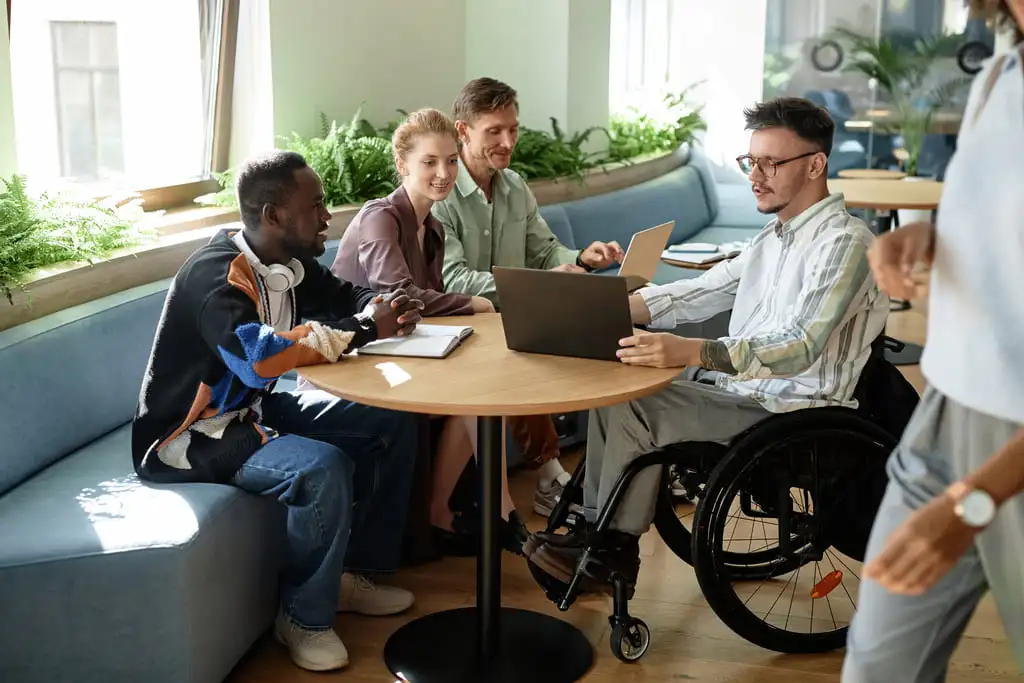
Accessibility
Accessibility signifies the removal of societal barriers that hinder full participation and inclusion. By addressing physical, attitudinal, communication, and social barriers, the Social Model aims to create an environment that enables people living with impairments or disabilities to participate in society on an equal basis with others. This approach emphasises the need for societal change to accommodate impairment as an expected part of human diversity rather than expecting people with impairments to adapt to existing societal structures.
Inclusivity
This approach focuses on creating a more inclusive society for everyone. Instead of viewing a person’s impairment or condition as their problem, we examine how societal structures can be unfair, often putting people at a disadvantage or excluding them.
For instance, when a disabled person is seeking employment, it shouldn’t be in our human nature to say “They can’t find a job because they are disabled.” Instead, we say, “They face challenges finding a job because many workplaces do not accommodate their needs.”
Discriminatory practices can manifest in various ways. This might include making assumptions about what a job seeker can or cannot do without any evidence or failing to consider reasonable accommodations such as allowing remote work or flexible shifts.
Participation
One successful participation initiative for disabled people in the UK is the “Specialist Employability Support” program by the UK government. This program offers mentoring and training courses to help disabled people find employment, particularly those who may not find adequate help through other government programs such as Work Programme, Work Choice, and Access to Work. The program aims to address work-related issues for persons with disabilities and provides valuable support for finding employment and integrating into the workforce.
Furthermore, Sport England, in collaboration with Activity Alliance, has been working to help disabled people get more active. They have produced research on successful and accessible communications, focusing on the vital components that contribute to engaging disabled people in sports and physical activities.
Leaf Complex Care is Applying a Strength-based Approach
Leaf Complex Care‘s strength-based approach focuses on empowering disabled people to live fulfilling lives by nurturing their unique abilities and talents. We achieve this by providing personalised care plans focusing on people’s independence, choice, and inclusion.
We primarily focus on:
Respecting people’s equal rights and human dignity
Matching the right support workers to meet people’s unique preferences and needs
Securing a safe and inclusive environment for all
Read the inspiring care journeys we are involved in as a social care provider to support people requiring complex care.
Discover how our commitment to equal rights and the Social Model of Disability is involved in helping people transform their own lives. Connect with us today, and let’s work together to create a more inclusive and empowering future for all.
Office Contact:
Download the White Paper Publication and stay up to date with the current state of the UK health and social care sector.


